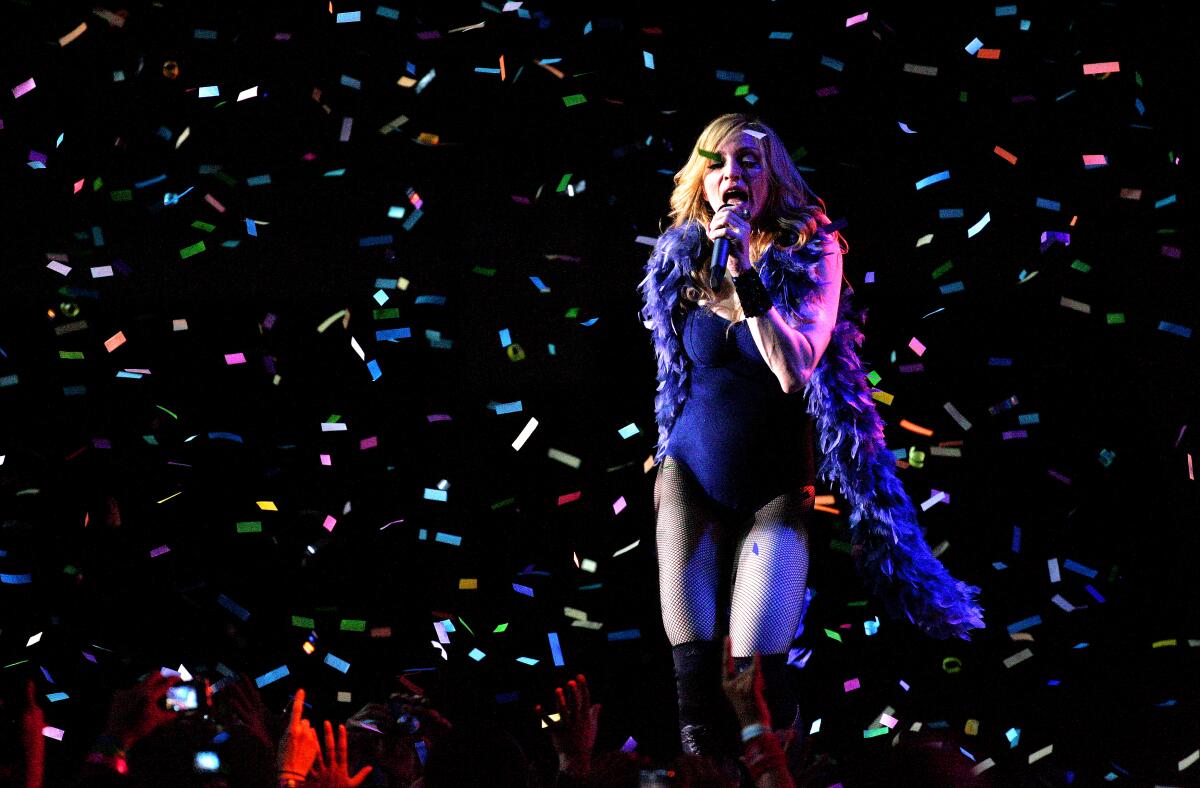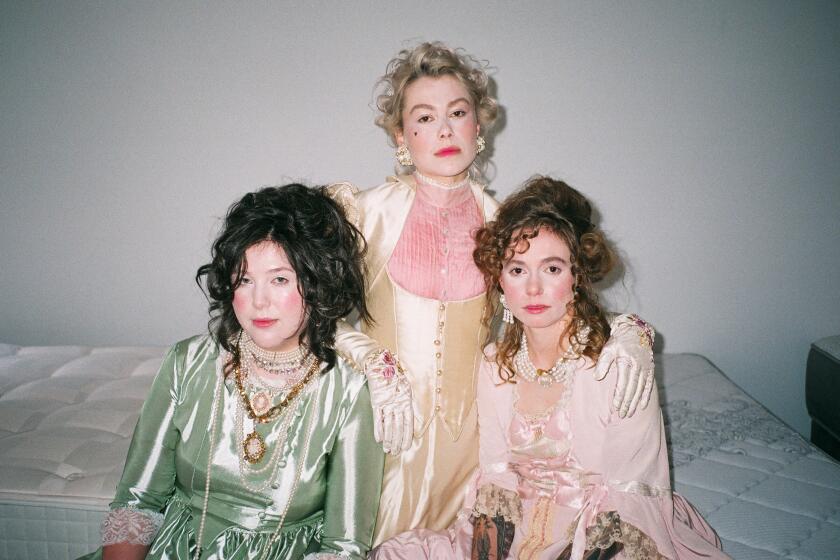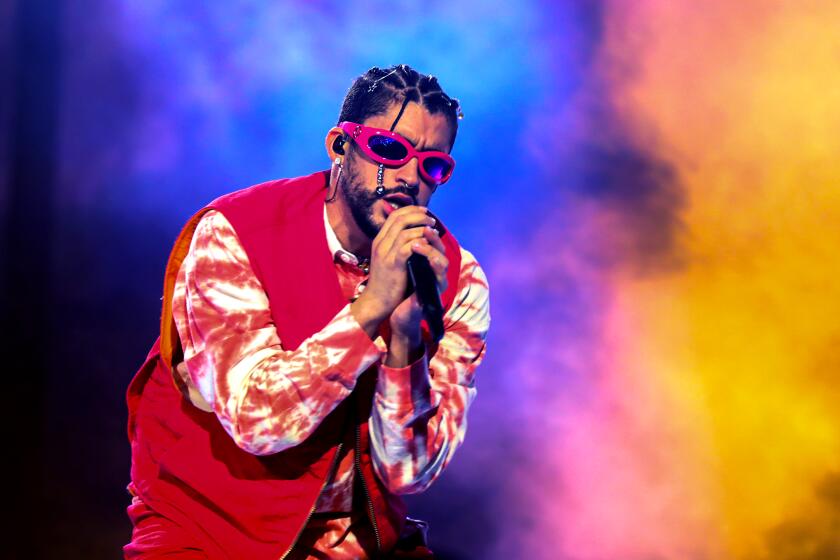EDM may have waned, but the Sahara Tent remains the beating heart of Coachella

- Share via
Whenever Michael Milano first parts the gates at the Coachella Valley Music and Arts Festival, the 30-year-old from San Francisco heads straight to the Sahara Tent.
“One of the most exciting things going in is seeing all the new stuff in there,” Milano said. The musician grew up in L.A. and has been to every Coachella since 2007. He once played an opening DJ gig on a tiny side stage back in 2011. For him, nothing quite compares to the LED temple where Coachella’s biggest DJ-driven acts, from EDM to hip-hop and K-pop, perform to tens of thousands.
“Every year, they step it up,” Milano said. ”The production is its own art piece. Even if the masses come for the pop music, they’ll stay for harder, cooler stuff in there.”
Paul Tollett, who co-founded Coachella and is president and chief executive of promoter Goldenvoice, built the Sahara Tent as the dance-driven corner of the fest, where Burning Man wooks, sunburned British ravers and bikini-clad bass fans converged. It’s where Daft Punk built its pyramid, where Madonna returned to her club roots, and where the likes of Avicii, Skrillex, Calvin Harris and Rihanna broke pop-EDM wide open.
‘It’s just a bottomless well of love and emotion,’ says Phoebe Bridgers of being in a band with Julien Baker and Lucy Dacus.
These days, it’s where trap titans like 21 Savage kick up mosh pits for the fest’s 125,000 daily attendees, and where 2023 headliner Blackpink made its 2019 U.S. festival debut, a historic moment for K-Pop.
“It felt like a dream to be able to perform our songs at a stage like that,” Blackpink wrote in an email to The Times. “We were so nervous even up until the moment we headed to the stage. We heard the crowd cheering, but we were still unsure of how the audience would react when we started singing. But when the crowd started screaming, “BLACKPINK IN YOUR AREA,” we were overcome. Who would have imagined thousands of people shouting ‘Playing With Fire’ in Korean!”

Blackpink is proof that a gig at the Sahara Tent can transform your career as new genres take off globally. If you want to see the arc of Coachella and where it’s going next, that dance floor is still the place.
“Paul Tollett and his team are great at monitoring the upcoming scenes that resonate with a young crowd,” said Stephanie LaFera, head of electronic music at agency William Morris Endeavor. “A lot of the artists who perform in the Sahara Tent have an insanely committed community that allows for these big cultural moments. You just want to go off in that tent.”
The nearly 100-foot-tall Sahara Tent is as old as Coachella, which comes to Indio’s Empire Polo Club for two weekends starting April 14. DJ-driven music was always at the core of the fest’s identity — the first Sahara bill had turntablist A-Trak and techno legends Juan Atkins, Kevin Saunderson and Richie Hawtin. U.K. big-beat duos Chemical Brothers and Underworld, both high-billed 1999 acts, are returning to the desert this year.
“Even before my time, I was so jealous seeing the lineups they’d booked,” said Anthony Gilmartin, 32, of Beverly Hills. “Portishead, Orbital, that was avant-garde back then. Coachella has stayed at the forefront by booking not what you like today, but what you’re going to love in six months.”

Back then, Coachella wasn’t a global hipster destination. The first fest famously lost a million dollars and took a year off to recover. The Sahara Tent was shunted to the farthest reaches of the festival grounds, by what became the Rose Garden VIP area. Early setups had just a few light panels to complement the music.
Other fests like Bonnaroo and Lollapalooza built dance-oriented stages during the EDM explosion of the 2010s. But none quite became shorthand for a whole cultural movement like the Sahara Tent did for Gen Z’s rap and electronic fans. In 2018, Goldenvoice moved the tent to the center of the grounds and grew it by 25%. The structure, built and designed by Koen De Puysseleir and Andrew Gumper of the Las Vegas production firm AG, now has a 250-foot wide stage and a custom 20-foot backstage runway just for hauling gear. Its chest-caving audio system comes from the Camarillo-based firm Rat Sound, with flame and laser tech from the century-old fireworks company Pyrotecnico. It’s held up under 90 mph thrashing desert winds, and has permanent concrete footing buried two feet beneath the grass of the polo afield — Goldenvoice digs it back up every spring.
The 2023 Coachella Valley Music and Arts Festival, which returns April 14-16 and April 21-23, is the first edition headlined entirely by nonwhite artists.
Sam Schoonover, Coachella’s head of innovation, said that Sahara was intended as “the place for high-energy music to test the limits of possibility, and how tech can allow fans to experience art in a new way.” Four years ago, they built a whole augmented-reality element for both fans in the pit and livestream viewers at home. “Fans grew to know it’s going to blow minds,” he said.
Artists knew it too. “It’s hard to do a bad job in there because the whole stage is so impressive,” said Tokimonsta, the L.A. producer and DJ who has played Sahara twice in her three sets over the years. “You feel like it’s not just about you, you’re just a tiny person up there. If you’re Rae Sremmurd or Blackpink, and a bit of razzle-dazzle lends itself to your music, it really can land in there.”
Chanel Vidal, a 33-year-old from L.A., will be attending her 12th Coachella this year. Part of her pines for the early days when the Sahara was “where all the freaks would hang out. I saw the craziest stuff in there — one time there was this naked guy just walking around.
“But every year they one-up themselves,” she continued. “Go back and look at old pics, you can count the screens behind the DJ. Now there are panels above you, behind you, all around you. It’s a full sensory experience.”
American dance music fans cite 2006 in the Sahara as the Big Bang for the EDM boom to come. That year, Daft Punk played atop its pulsing light pyramid for a set that fans regard as a near-religious experience today. That same weekend, Madonna popped in for a surprise show that drew connections back to her downtown N.Y.C. club days. A whole sector of the live music industry ramped up, and helped finally turn the U.S. into a festival-biz powerhouse.

“Coachella has always taken electronic music seriously and given it prime billing,” LaFera said. “It’s expanded the reach of the genre to fans who might not be comfortable going to a rave or nightclub. When I managed Kaskade, the Sahara Tent was overflowing, there were oceans of people spilling out. It completely changed the game for him and the rooms he got to play after.”
In 2011, fans got a look at the tent’s future when a rowdy group of rappers, singers and producers from all over L.A. — then known as Odd Future Wolf Gang Kill Them All — performed one of its first live shows. The ramshackle set was barely a half hour, but it yielded two headline-caliber artists (Frank Ocean, who tops the Sunday bill this year, and Tyler, the Creator) and boosted two more newcomers (producer/singer Syd, and later, her future bandmate Steve Lacy).
As the EDM boom leveled off and the fest shifted to younger crowds, rap acts like Post Malone and Lil Uzi Vert turned Sahara from a retina-searing rave den into a nightclub blown up to insane proportions.
“I always laugh when old heads say it’s a pop fest now,” said Dylan Moore, 25, from L.A. He admiringly cited last year’s Fred Again set as a clear sign that Goldenvoice hasn’t lost its touch for finding DJ-driven acts right before they crest. “Those fans have got to come to terms with the fact that the scene isn’t marketed towards them anymore. Chilled-out dance and hip-hop and international pop reigns supreme now.”
“It only makes sense to shift to find the Zoomers,” said Hector Bustamante, 27, from Chico. He’s a rap fan who loved seeing Mac Miller and Gucci Mane in their primes at Coachella, and this year he’s pumped to see trap producer Metro Boomin.
“I keep getting blown away by the production and the stage concepts in the Sahara,” he continued. “There’s always something that’s gonna shock you in there.”

With Bad Bunny (the first Spanish-language headliner in the fest’s history) and Blackpink (the first South Korean group and first all-female band to headline) atop the Main Stage this year, the Sahara’s range will likely go wider, now that multiple generations of headliners have emerged from there.
“We still remember the very moment when we heard that we were going to be performing at Coachella. We were all together at that time, and all of us were in disbelief,” Blackpink wrote. “In that moment, the history of us trying to be singers flashed by like a panorama, and everything we overcame to become Blackpink was worth it.”
If nothing else, a 45-minute prime-time set in there produces enough serotonin to last a whole career.
“Playing there is one of those milestones where if I ever feel bad about myself,” Tokimonsta said, “I can look back at that show and remember why I do this.”
More to Read
The biggest entertainment stories
Get our big stories about Hollywood, film, television, music, arts, culture and more right in your inbox as soon as they publish.
You may occasionally receive promotional content from the Los Angeles Times.











